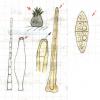
07-12-2025 16:07
Arnold BüschlenHallo, ich habe in einer Moos-Aufsammlung (epiphy

08-12-2025 21:04
Mark Stevens"Hello everyone,I'm relatively new to microscopy (

09-12-2025 12:06
 Andgelo Mombert
Andgelo Mombert
Bonjour,Je recherche l'article concernant Hypobryo

08-12-2025 18:59
 Lothar Krieglsteiner
Lothar Krieglsteiner
.. found by a seminar-participant, I do not know t

08-12-2025 17:37
 Lothar Krieglsteiner
Lothar Krieglsteiner
20.6.25, on branch of Abies infected and thickened

16-03-2014 22:00
Hello,I found this species a few months ago but ha

08-12-2025 13:39
Thomas Læssøehttps://svampe.databasen.org/observations/10572899
Setose pyrenomycetes
Hans-Otto Baral,
08-05-2011 21:42
 I was asked by a colleaque to post here this pyrenomycete which he cannot identify: Zotto Pyrenomycet spec. (setose) Habitat: Populus-stump, Perithecia superficial in groups, pyriform, dark brown-black, thick-walled, soft, textura angularis, at the base with redbrown hyphae, setose at the upper part; setae erect, stiff, pluricellular (3-5-c.), thick-walled, fistular, smooth, golden-brown, rounded at the top, 189-204 x 9,8-12,3 µm. Asci 8-sp., clavate, obtuse, short-stalked, apex small, inamyloid (aqua dest. + Lugol), 120 x 18 µm. Paraph. numerous, hyaline, moniliform, cylindric and sometimes branched at the upper part. Spores 4-c., ellipsoid-fusiform, unicolorous, yellow-ochraceous, thin-walled, smooth, sometimes constricted in the middle, finely guttate, 29,5-31,9-33,5 x 8-8,5-9 µm (aqua dest., rehydrated).
I was asked by a colleaque to post here this pyrenomycete which he cannot identify: Zotto Pyrenomycet spec. (setose) Habitat: Populus-stump, Perithecia superficial in groups, pyriform, dark brown-black, thick-walled, soft, textura angularis, at the base with redbrown hyphae, setose at the upper part; setae erect, stiff, pluricellular (3-5-c.), thick-walled, fistular, smooth, golden-brown, rounded at the top, 189-204 x 9,8-12,3 µm. Asci 8-sp., clavate, obtuse, short-stalked, apex small, inamyloid (aqua dest. + Lugol), 120 x 18 µm. Paraph. numerous, hyaline, moniliform, cylindric and sometimes branched at the upper part. Spores 4-c., ellipsoid-fusiform, unicolorous, yellow-ochraceous, thin-walled, smooth, sometimes constricted in the middle, finely guttate, 29,5-31,9-33,5 x 8-8,5-9 µm (aqua dest., rehydrated).
Jacques Fournier,
09-05-2011 15:05

Re:Setose pyrenomycetes
Hi Zotto,
in some respects this fungus recalls some species formerly placed in Lasiosphaeria around L. stuppea and L. coacta, but not a species I am aware of. The pyriform shape of ascomata and short-stalked asci do not match well this group of species, but I see no other lead for the moment. Data on dimensions of ascomata, thickness and structure of the wall would make the description more complete.
Cheers,
Jacques
in some respects this fungus recalls some species formerly placed in Lasiosphaeria around L. stuppea and L. coacta, but not a species I am aware of. The pyriform shape of ascomata and short-stalked asci do not match well this group of species, but I see no other lead for the moment. Data on dimensions of ascomata, thickness and structure of the wall would make the description more complete.
Cheers,
Jacques

